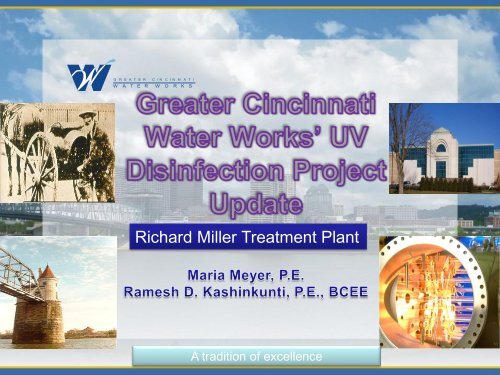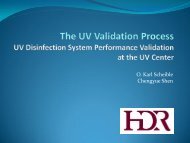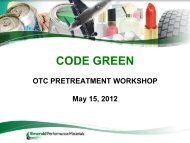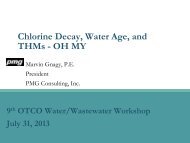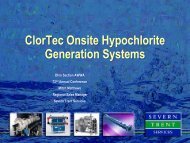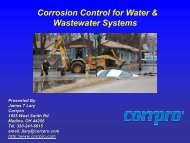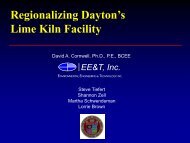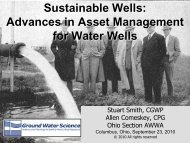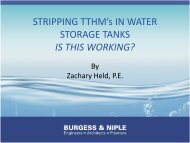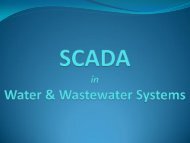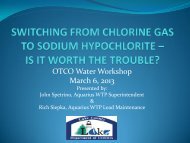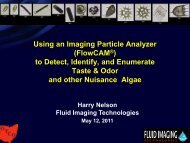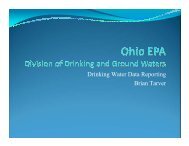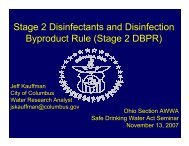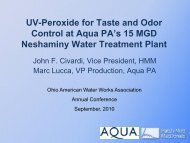Richard Miller Treatment Plant - Ohiowater.org
Richard Miller Treatment Plant - Ohiowater.org
Richard Miller Treatment Plant - Ohiowater.org
You also want an ePaper? Increase the reach of your titles
YUMPU automatically turns print PDFs into web optimized ePapers that Google loves.
G R E A T E R C I N C I N N A T I<br />
W A T E R W O R K S<br />
<strong>Richard</strong> <strong>Miller</strong> <strong>Treatment</strong> <strong>Plant</strong><br />
A tradition of excellence
Project history<br />
Driving forces<br />
Feasibility<br />
• Process<br />
• Hydraulic<br />
Design<br />
Construction<br />
Questions<br />
2
Feasibility Study 1999-2000<br />
Hydraulic Analysis and Process Location<br />
Assessment 2001-2004<br />
Preliminary Design and Master Planning 2005-2008<br />
Advanced Oxidation Pilot 2007-2008<br />
Final Design 2009-2010<br />
Construction October 2010 – January 2013<br />
Warranty Testing 2012-2013<br />
3
1993 Milwaukee cryptosporidium outbreak<br />
Long Term 2 Enhanced Surface Water <strong>Treatment</strong> Rule<br />
(LT2ESWTR) and “BIN” classification<br />
Vulnerability of source water to contamination<br />
• Known and emerging contaminants<br />
• Historic crypto data analysis<br />
• Robustness of existing treatment barriers<br />
• Multiple inactivation barriers<br />
• Wastewater treatment plant<br />
4
23%<br />
Lake Michigan<br />
33%<br />
53%<br />
Water plant<br />
1<br />
Water plant<br />
2<br />
Sewage tx<br />
Intake 1<br />
Sewage plume<br />
Intake 2<br />
<strong>Plant</strong>s were meeting the existing regulations at that time<br />
People not receiving water directly from <strong>Plant</strong> 2 also got infected due to<br />
commuting for work, or other business and drank the water contaminated<br />
with cryptosporidium<br />
5
Disease (Cryptosporidium) outbreak in 1993 from drinking<br />
water<br />
<strong>Plant</strong>s were meeting all drinking water regulations<br />
• Nearly 400,000 became sick<br />
• 100 - 150 deaths<br />
Total estimated costs by Center for Disease Control<br />
(2003)<br />
• Total cost of illness – $96.2 M<br />
o $31.7 M in medical costs<br />
o $64.6 M in productivity costs<br />
6
Cumulative Log Credit for Cryptosporidium<br />
Coagulation<br />
& Rapid<br />
Settling<br />
Conventional<br />
<strong>Treatment</strong><br />
Reservoirs Secondary<br />
Sedimentation<br />
Sand<br />
Filtration<br />
< 0.15<br />
NTU CFE<br />
GAC<br />
Filter<br />
Clearwells<br />
RA<br />
W<br />
7<br />
Point of Bin<br />
Determination<br />
+ 3-log + 0.5-log 1<br />
+ 0.5-log + 0-log<br />
To<br />
Distribution<br />
System<br />
Indicates that credit was<br />
achieved using a physical<br />
removal barrier.<br />
6<br />
5<br />
4<br />
3<br />
Bin 4<br />
Bin 3<br />
Bin 2<br />
2<br />
1<br />
0<br />
Process<br />
1<br />
An additional 0.5-log credit may be available for < 0.15 NTU on individual filters.<br />
7
•Higher the crypto #s, greater the treatment required<br />
8
Spore concentrations<br />
100000<br />
10000<br />
1000<br />
100<br />
10<br />
1<br />
0.1<br />
Ohio First Second Sand GAC Finished<br />
RAW LMEF FLIN GACI WSW CW1E<br />
River Settling Settling Filters Filters Water<br />
Spores are a type of micro<strong>org</strong>anism. We see that spores are reduced through<br />
treatment, but their presence in the finished water is an indication that treatment is<br />
not 100% effective at their removal.<br />
9
Upstream Wastewater<br />
plants<br />
Mixing and dilution<br />
Chlorine resistant<br />
microbes<br />
EDC, PPCPs, etc.<br />
10
Option<br />
Option 1: Current treatment process with an<br />
additional coagulation step*<br />
Total Annual<br />
Cost ($M)**<br />
0.5<br />
Option 2: Post GAC – Ultraviolet 1.8<br />
Option 3: Micro Filtration (MF) 21<br />
Option 4: Ultra Filtration (UF) 16<br />
Option: Post sand-filter UF and Post-GAC UV 20<br />
*Option 1 was piloted at GCWW. The option did not show significant benefit<br />
when tested on our water.<br />
**1998 dollars developed by USEPA, LT2 Cost and Technology Document.<br />
$ includes operating costs and capital at 6% over 20 years. $ does not<br />
include site complexity, engineering fees, etc.<br />
11
Radio<br />
IR<br />
Visible<br />
Light<br />
UV X-Rays<br />
• Ultraviolet (UV) light is<br />
a naturally occurring<br />
form of light<br />
<br />
UV-A UV-B UV-C<br />
Vacuum<br />
UV<br />
• In water treatment, UV<br />
is a physical disinfection<br />
process that does not<br />
use any chemicals<br />
300nm<br />
200nm<br />
• UV covers a range of<br />
light wavelengths<br />
Germicidal Range<br />
Electromagnetic Spectrum<br />
• UV light in low doses<br />
inactivates diseasecausing<br />
microbes<br />
12
Protozoa &<br />
Bacterial Spores<br />
Organism<br />
Cryptosporidium<br />
Bacillus subtilis<br />
UV<br />
(40 mJ/cm2)<br />
Cl2<br />
(1 mg/L &<br />
24 hours)<br />
UV & Cl2<br />
Good Poor Good<br />
Good Poor Good<br />
Toxoplasma gondii Good Poor Good<br />
Bacteria<br />
E. Coli Good Good Good<br />
Mycobacterium terrae Fair Good Good<br />
Viruses<br />
Adenovirus Poor Good Good<br />
MS-2 Poor Good Good<br />
PRD-1 Fair-Poor Good Good<br />
13
Four potential locations were investigated<br />
Possible locations for UV were evaluated. Energy<br />
costs, lamp types and other factors were evaluated<br />
considering water quality, reliability, and flexibility to<br />
run under different operational scenarios<br />
14
Relative Benefit<br />
Cost & Cost Benefit ($k)<br />
1.2<br />
1<br />
0.8<br />
0.6<br />
0.4<br />
0.2<br />
7,000<br />
5,000<br />
3,000<br />
1,000<br />
-1,000<br />
-3,000<br />
Reliability<br />
Water Quality<br />
Flexibility<br />
Maintenance<br />
Operation<br />
GCWW used a<br />
cost-benefit<br />
model to select<br />
the best options<br />
considering cost<br />
benefit, and total<br />
annualized cost<br />
reliability, and<br />
flexibility, water<br />
quality, operation,<br />
and maintenance<br />
Cost Benefit<br />
0<br />
Effluent of Each<br />
contactor<br />
After GAC in<br />
New Bld<br />
3 4<br />
Alternative<br />
-5,000<br />
Total Anualized Cost<br />
15
Wedeco<br />
Medium Pressure, 5-lamp<br />
Reactor (Calgon)<br />
designed for 4-log<br />
(99.99%) crypto<br />
inactivation<br />
16
8 validated reactors<br />
for 4-log crypto<br />
MP (max flow 35<br />
mgd/reactor)<br />
5-lamp configuration<br />
guaranteed lamp,<br />
sleeve & ballast life<br />
Guaranteed power<br />
costs<br />
17
Max headloss at design<br />
flow (240-mgd)
158 feet<br />
111 feet<br />
19
Facility Construction<br />
Process Engineering<br />
Instrumentation, Control, and<br />
Programming<br />
22
Final Design<br />
Construction<br />
Notice to proceed<br />
UV Site Work<br />
Substantial completion<br />
Validation review<br />
Reactor Factory testing<br />
Regulatory Approval<br />
Operational Readiness Testing<br />
Functional Demonstration Testing<br />
Site Acceptance Testing<br />
Warrantee Testing<br />
PROJECT CHRONOLOGY<br />
2010 2011 2012 2013<br />
Q1 Q2 Q3 Q4 Q1 Q2 Q3 Q4 Q1 Q2 Q3 Q4 Q1 Q2 Q3 Q4<br />
23
Impact on current operation<br />
• Partial plant shutdowns (Yard piping and facility tieins)<br />
• Maintaining <strong>Plant</strong> Operation during construction<br />
• Chemical deliveries<br />
24
Construction Constraints<br />
• May 1 through September 30, no construction<br />
activities that would reduce plant production below<br />
240 MGD<br />
• Seal wells/CCW lines – no more than one out at a<br />
time to keep plant at half capacity (~120 MGD)<br />
• Filter Water Weir Chamber – Max 2 shutdowns, max<br />
30 hours each<br />
• WW Recovery Basin/WW Return Pump Station – max<br />
3 shutdowns, max 24 hours each<br />
29
OEPA/DEFA State Revolving Loan Funding for project<br />
Questions/Comments?<br />
UV Bld. w/solar panels<br />
GAC bld.<br />
Cl2 bld.<br />
30
Construction $ = $320,000<br />
Offset the energy consumption of<br />
the facility in an environmentally<br />
sound manner.<br />
The capacity is 45 KW, which will<br />
represent one of the larger such<br />
installations in the state.<br />
The solar panel system will offset $20,000<br />
per year in energy costs.<br />
31
UV Submittals' review from the Vendor<br />
(Calgon Corporation)<br />
• Dose control & monitoring strategies<br />
• Startup issues, safety (Hg spills)<br />
Review of Validation Report<br />
• Reactor validation<br />
• Hydraulics and dose distributions<br />
• Monitoring equations and algorithms<br />
34
Any questions?<br />
42


